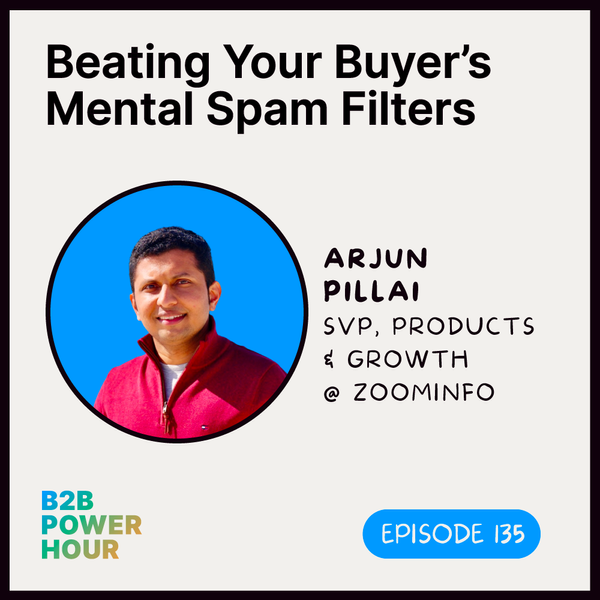Episode Summary
We’re all buyers and sellers in some way. We’ve received spam, and we’ve sent it too (if you’re honest).
Even if you have a great prospecting list and a solid B2B sales strategy, you’re still hitting people’s mental spam filters.
The bad news is that they’re hard to break through.
The good news is that there are ways to boost your odds of reaching prospects.
SVP of Product & Growth at ZoomInfo Arjun Pillai joins us for a deep dive into how you can get past mental spam filters, which — just like Google’s spam filter — have only grown more resilient over the last decade.
If you want to create a B2B contact list that actually delivers, you need to change how you’re perceived by prospects. A solid B2B sales strategy means congratulating prospects on real milestones, not just asking generic questions. This is especially important when considering scale — how and when do you personalize your outbound? And how do you keep it friendly but automated?
But before you even message, you need to consider data and proxies (think ZoomInfo’s Scoops). And most importantly, you need to fully understand which intent you’re using so you can reach the right segment. The message needs to fit the medium to avoid reinforcing spam filters.
Here’s a shocker: cold calling isn’t dead. Well crafted emails can be strengthened by thoughtful voicemails, which encourage prospects to take a fresh look at what you’re offering.
In this episode of B2B Power Hour, join us as we dive into:
- How you should phrase texts (keep it natural, stupid!)
- What to do — and what not to do — when you automate outbound
- The importance of where intent data falls in the funnel — and how to avoid misusing it
- TAM and content syndication
- Why voicemail still might be a good option
- The right metrics to look for and top trigger events
Featured on the B2B Power Hour: Arjun Pillai
What he does: SVP of Product & Growth at ZoomInfo
Key quote: “It’s about taking the intent and then slicing and dicing it in the right way so that you get to the right segment — rather than just getting a set of intents and spamming everybody.”
Where to find him: LinkedIn
B2B Power Plays
Top takeaways from this week’s conversation
💡 Avoid the mental spam filter: Make messages natural.
Any text should look like a conversation. It shouldn’t feel all salesy. If you congratulate someone on their work anniversary or wish them a happy birthday, you’re showing human interest. Asking straight up for a demo, pushing a product or sending pricing right away doesn’t work. It’s too pushy, and it hits people’s mental spam filter straight away.
Even the word choice comes into play. Work anniversaries are milestones to be proud of. Asking someone if they’re currently hiring is just disconnected. Prospects won’t read any more if it doesn’t look like a text, but something more natural could hook them in.
💬 Even if there are scale-based tradeoffs, make sure you’re using technology to your advantage.
In the race to automate outbound, templated messaging is a go-to option for time-strapped sellers — especially for smaller deals. Not everyone has time to personalize a message for a $5K sale.
But good, relevant messages can still break through mental spam filters by looking further back down the pipeline: starting with the target segment. This is unfortunately where many people go wrong.
If you have a TAM of 90,000 companies of which only 5% maximum are buying, that 5% is your segment. Use Scoops to establish dynamic trigger events for your TAM. Sellers should be able to answer the questions of “why change?” and “why now?” If you can’t answer both of those questions, it’s time to do more digging.
📲 Know your intent and where it falls in the funnel.
Sales teams often misuse intent data by sending messages at the wrong time with bad automation. The result? It strengthens your prospects’ mental spam filters. But if you have a deep understanding of the intent you’re using, this won’t happen.
You need to determine where it falls in the funnel (top, middle or bottom) and craft the message accordingly, while choosing the right channel. Don’t do random reach-outs without additional filters layered on (like ICP) — the company might not even be in the same market. Take the intent, then slice and dice it to find the right segment.
Episode Highlights
Inflection points from the show
[1:10] Mental spam filters: We’re all buyers and sellers at some point, and we’ve all come into contact with spam. Arjun takes us through how spam filters have evolved over the last decade.
[3:16] Clean intelligence: A little birdie told us about Arjun’s sales intelligence data deal.
[7:06] The first, great DM: Texting for a milestone like “congrats on your work anniversary” is okay. “Are you hiring?” isn’t.
[9:32] Juice worth the squeeze: There’s a race to automate outbound… and there are trade-offs at scale. So where does the personalization begin (and end)?
[13:07] Leveling with accounts: At a data level — before messaging — you want proxies (like Scoops for ZoomInfo). Arjun gives the lowdown and dives into the importance of where intent data falls in the funnel.
[18:04] Golden nuggets: We break it down further with Arjun talking TAM and content syndication.
[21:91] Misusing intent: You need to understand the intent you’re using, slice and dice, and source the right segment. Make sure the message fits the medium, otherwise you reinforce spam filters.
[28:45] Cold callers rejoice: Thoughtful voicemails do actually still work sometimes, especially in conjunction with well thought-out emails.
[35:27] The metrics to look at: Revenue and qualified pipeline are great, but you should pay attention to open rates, connect rate for cold calling and domain authority.
[41:14] Top trigger events: We share our thoughts on great trigger events to look for by figuring out the proxies.

